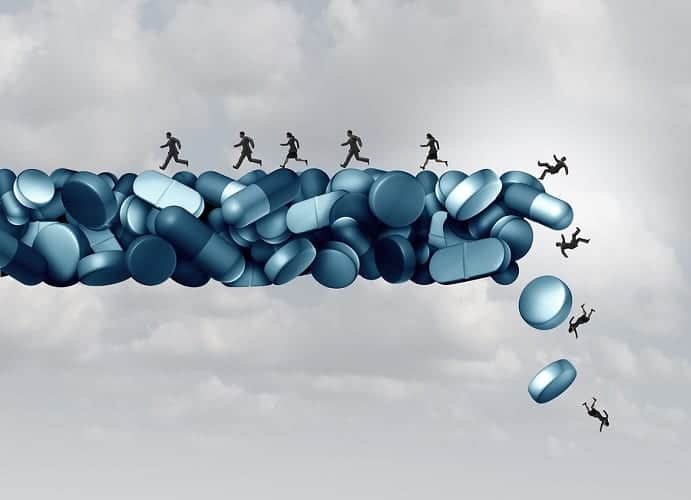It is almost an unwritten rule that rock n’ roll and drugs go hand in hand. From the Beatles’ experimentation to the Grateful Dead’s glorification, drugs have nearly always been a part of music. Unfortunately, drug abuse and addiction have also been a part of the lives of many musicians. Twenty-five years ago, Scott Weiland released his first album with Stone Temple Pilots. Less than two years ago, the musician passed away in his sleep from an accidental drug overdose.
Scott Weiland’s Last Interview:
In Memory of Scott Weiland – A Cautionary Tale
The memory (and music) of Scott Weiland lives on. But the life of a musician, a father, a family member and a friend was cut short due to the tragedy of drug abuse. More than anything, Scott Weiland’s story shows the importance of preventing accidental overdose. Weiland was a talented musician surrounded by drug culture and the pressure of fame. But the truth is drug abuse, addiction and overdose can happen to anyone. To get to the bottom of what preventing accidental overdose looks like, we address all of these questions:
- How did Scott Weiland die?
- What does accidental overdose look like?
- What is a drug overdose?
- Is a drug overdose a sign of addiction or substance abuse?
- What can you do to prevent an accidental overdose?
Understanding the Story of Scott Weiland

Step One to Avoiding Accidental Overdose
More than anything, this highlights one of the most important steps that anyone can take to preventing an accidental overdose: acknowledging the problem. Before he turned fifty, Scott Weiland was dead from an accidental overdose of cocaine, alcohol and MDA. This was not a one-off with drugs. Instead, it was the many years of struggling with addiction and abuse that brought the musician to that point. Scott Weiland’s story of drug abuse and eventual accidental overdose is a warning shot across the bow for anyone who faces substance abuse and dependence. It is not a happy road to go down – thankfully, it is almost never too late to turn around.
What Does Accidental Overdose Look Like?
An accidental overdose is when someone takes too much of a drug for any number of reasons. It could be because they are trying to reach the same kind of high they originally experienced, or because they do not realize how much of the substance they ingest. A drug overdose can be either accidental or intentional. If someone is attempting to commit suicide by taking drugs, it is ruled intentional. Any other form of drug overdose is considered accidental.
Signs of Accidental Overdose to Look For
There are some major signs of a drug overdose to be on the look out for. Knowing what these signs look like and how to respond could save someone’s life. The most common drug overdose symptoms include:
- Vital Signs: Someone who has overdosed may have problems with their pulse, temperature, blood pressure, or breathing.
- Behavioral Signs: An overdose on drugs often causes confused thinking, sleepiness or unconsciousness.
- Physical Signs: Someone who has overdosed will usually experience physical pain in their chest or abdomen. An overdose also causes nausea and vomiting.
An overdose becomes much more likely when mixing several different drugs. Scott Weiland, for example, had cocaine, amphetamines and alcohol in his system when he overdosed. If you see any of these signs in someone close to you, you should contact emergency services immediately.
Preventing Accidental Overdose is Possible
Scott Weiland may have been a famous musician, but drug overdose can affect anyone and anywhere. Thankfully, these kinds of accidental overdose deaths can be prevented. Close to 98% of all overdose deaths were from cocaine, opiates and alcohol. 60% of those were due to a combination of those three drugs. The best way to prevent an accidental overdose is to avoid using drugs altogether. Sometimes due to the extent of addiction, people do not see that as a possible option.
Steps for Preventing Accidental Overdose
Even outside of stopping drug use altogether, there are several ways to reduce the risk of overdose.
- Don’t Mix: Mixing substances can create a dangerous situation for the user. When mixing cocaine, alcohol and opiates it is much more difficult to keep track of how much of the substance has been used. This will overload your body’s system sooner rather than later.
- Watch Your Tolerance: Becoming tolerant of a drug’s effect is one of the first signs of drug abuse. This often leads people to use more drugs than their body can handle.
- Know the Quality: Some street drugs are cut with dangerous ingredients. These become much more dangerous because the drug user may not know how much they are taking. Synthetic heroin, for instance, should be avoided at all costs.
- Trust Somebody: Think of somebody that you can call and ask for help when you run into trouble. Many people try to hide their addiction and drug use. Keeping drug abuse a secret is the opposite of preventing an accidental overdose.
Understanding Overdose as a Sign of Addiction
There are no two ways about it: if you have overdosed on drugs or alcohol, it almost always means that addiction is part of your life. As the life and death of Scott Weiland shows, a drug overdose can sometimes be fatal. If you have overdosed on drugs or alcohol and lived through it, consider this your wakeup call. It is already clear that preventing a drug overdose is important. But the best way that you can prevent an accidental overdose is by not using drugs at all. In an open letter addressing her ex-husband’s death, Mary Forsberg Weiland made one thing clear: drugs are not cool. Drug addiction and abuse took Scott Weiland away from his children, ruined his relationships, and ultimately caused his death at a relatively young age. “Progress, not perfection, is what your children are praying for. Our hope for Scott has died, but there is still hope for others. Let’s choose to make this the first time we don’t glorify this tragedy with talk of rock and roll.” ~ Mary Forsberg Weiland, Scott’s ex-wife
The Hope of Recovery from Substance Addiction
Thankfully, even if you have struggled with substance abuse in the past or are currently struggling with addiction, this does not have to define your life story. There are many different ways that you can choose to get help for your problem with drugs. Residential rehab, intensive outpatient treatment programs, and anonymous support groups (like Narcotics Anonymous) are all fantastic options. All three of these approaches accomplish the most important element of recovering from drug addiction: reaching out and asking for help. If you have more questions about the importance of preventing accidental overdose, do not hesitate to contact us today.

